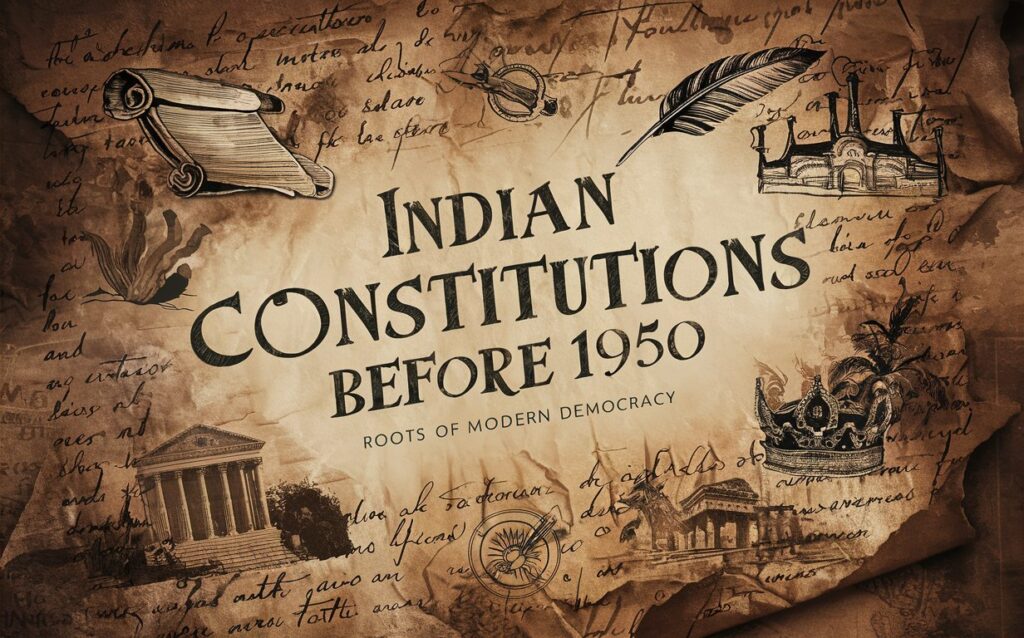🏛️ The History of Indian Constitutions Before 1950: Foundations of Modern Democracy
The history of Indian constitutions before 1950 reveals a long and complex journey toward democratic self-rule. While India officially adopted its current Constitution on January 26, 1950, the seeds of constitutional development were sown much earlier—through colonial charters, reform acts, and nationalist movements that shaped the nation’s legal identity.
Understanding these early constitutions uncovers how India transitioned from a British colony to a sovereign democratic republic.

📜 Regulating Act of 1773: The First Step Toward Governance
The journey begins with the Regulating Act of 1773, passed by the British Parliament to control the mismanagement by the East India Company. This act:
- Created the Governor-General of Bengal, a central authority
- Established the Supreme Court at Calcutta
- Marked the first time Britain asserted political control over Indian administration
This act wasn’t a constitution in the modern sense, but it laid the foundation for centralized governance in India.
🧾 Pitt’s India Act of 1784: Dual Government Model
The Pitt’s India Act introduced a dual system of control—dividing power between the Company and the British Crown through a Board of Control. This marked the first real step toward formalizing colonial oversight of Indian affairs.
📚 Charter Acts (1813, 1833, 1853): Expanding British Control
Each Charter Act renewed the East India Company’s rule while increasing British legislative power:
- 1813: Ended Company’s trade monopoly, opened India to Christian missionaries
- 1833: Made Governor-General of Bengal the Governor-General of India
- 1853: Introduced an open competitive system for Indian civil services (first move toward a merit-based bureaucracy)
These acts began introducing institutional reforms, slowly setting a framework for governance.
🔥 Revolt of 1857 and Government of India Act 1858
After the Revolt of 1857, the British dissolved the East India Company and brought India under direct Crown rule via the Government of India Act, 1858. Key highlights:
- India became a direct colony of the British Crown
- A Secretary of State for India was appointed in London
- British Parliament took legislative authority over India
This act essentially created a colonial constitution directly managed by Britain.
🏛️ Indian Councils Acts (1861–1919): Representation Begins
The Indian Councils Acts gradually expanded Indian participation in governance:
- 1861: Introduced Indians into legislative councils (nominated only)
- 1892: Allowed Indians to discuss the budget
- 1909 (Morley-Minto Reforms): Introduced communal electorates (Hindus and Muslims voted separately)
- 1919 (Montagu-Chelmsford Reforms): Introduced diarchy—some powers to Indians in provinces
These acts were significant for involving Indians in the legislative process for the first time.
📑 Government of India Act, 1935: Blueprint of Modern Constitution
The 1935 Act is considered the most important pre-1950 constitutional document. Its impact was massive:
- Proposed an All-India Federation
- Divided powers into Union, Provincial, and Concurrent Lists
- Introduced bicameralism, provincial autonomy, and independent judiciary
- Created the Reserve Bank of India (RBI)
Even though the federation was never fully implemented, much of India’s 1950 Constitution was based on this Act.
✊ The Indian Independence Act of 1947
The final legal instrument before the adoption of the Indian Constitution was the Indian Independence Act, passed by the British Parliament:
- Granted independence to India and Pakistan
- Abolished British sovereignty
- Gave constituent assemblies full powers to draft their own constitutions
This act formally ended British legal authority and led directly to the framing of the 1950 Constitution.
📘 Conclusion: A Rich Legacy Before 1950
The history of Indian constitutions before 1950 showcases a gradual shift from British rule to Indian autonomy. Each document, reform, and act played a role in shaping the legal traditions and political framework that would later culminate in the modern Indian Constitution. Understanding this evolution is essential to appreciating India’s democratic roots in 2025.
DoFollow External Links:
Internal Links:



Post Comment